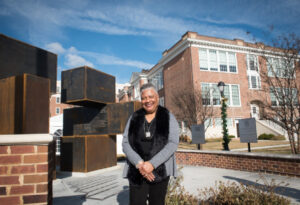 by Jon Baliles
by Jon Baliles
Richmond unveiled a new sculpture last week on the site of the old Westhampton School (near St. Mary’s Hospital) that marked the desegregation of the West-End school in 1961. The 12-foot piece, entitled “Strides,” marks that day when 12-year old student Daisy Jane Cooper (now Jane Cooper Johnson) arrived as the first African American student following a three-year legal battle that took a U.S. District Court’s intervention. (Photo courtesy of Bon Secours.)
At age 9, Jane was having to travel five miles to get to the segregated Carver Elementary School. In 1958, civil rights attorney Oliver Hill submitted an application to the Richmond City School Board on behalf of Jane’s mother to transfer Jane to the all-white Westhampton School. The State Pupil Placement Board rejected the request, which led to the lawsuit that lasted three years and resulted in a groundbreaking victory in 1961. It impacted not only Richmond City schools but other localities as well — and the ruling meant that African-American students no longer required permission from the State Board to attend a white school.
A year after first walking through the doors of Westhampton, Cooper also became the first African-American student to integrate Thomas Jefferson High School in September 1962, after deciding she wanted to go there instead of the all-black Maggie Walker High School.
You can watch this fascinating 2003 interview with Jane Cooper (Johnson) and her mother, Elizabeth, that is preserved in the VCU Libraries Digital Collection. Cooper (Johnson) talks with her mother about the challenges and hesitations about the filing of the lawsuit, being asked not to play outside, the intimidation she faced, what her first day at school was like, and what it was like at school after she moved on to Jefferson.
According to Bon Secours, the sculpture was designed by local artists Matt Lively and Tim Harper and was created to evoke “experienced feelings surrounding the history that allows for conversations and understanding” in regards to incidents that occurred at Westhampton School.
“Strides,” aptly named to honor those first courageous steps Jane Cooper Johnson took on the steps leading to the Westhampton School in 1961, consists of two 12-foot by 6-foot forms. Standing four feet apart, the two mirrored forms create negative space between them in the shape of a plus sign, which serves as a visual symbol of integration. By entering and moving through this negative space, one can sense tension from the close proximity of surrounding forces. This exercise is meant to inspire viewers to consider what Ms. Cooper Johnson must have felt that first day of school, with the weight of mounting pressures all around her.
Emerge from the interior and walk around the sculpture to either end and one can see that “Strides” is, in essence, two plus signs consolidated into one experience. This is the story of integration: the joining of many for the strength of all.
Jon Baliles is a former Richmond city councilman. Republished with permission from RVA 5×5.

Leave a Reply
You must be logged in to post a comment.